Welcome to the GoTo Astronomy Observational Facility WebsiteOverview |
|
| This facility provides state-of-the art astronomical observation facilities for introductory astronomy laboratory students as well as school and community groups through both tours and summer astronomy camp activities. It serves through workshops to interact with K-12 teachers as well as college and university faculty in the art of planning and making astronomical observations with modern computer controlled telescopes (GoTo telescopes) and in the process allow them to initiate such observation programs at their own schools and institutions. The availability of GoTo telescopes at relatively low cost makes them accessible even under the budget constraints of most schools and the ease of their use makes them ideal for teachers who are not experts in making such observations. | |
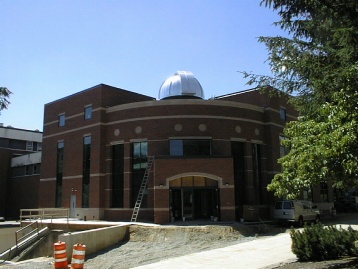 |
|
The Philosophy |
|
| The laboratory component of college level introductory astronomy courses has always faced a number of difficulties in doing real, analytical and meaningful outdoor observations. These complications are not inherently present in physics, chemistry and biology laboratory experiments. These difficulties included the quality and user friendliness of the telescopes, inherent complexities dealing with photography, labor of setting up and taking down the instruments every night and the unpredictability of the weather. The GoTo lab and its instrumentation deals with each of these problems to make it possible for astronomy lab students to carry out quantitative observations at a level comparable to (and in some ways exceeding) work done in the other introductory science laboratories. In the process the facility also becomes ideal for outreach programs of all sorts as well when not in use for the laboratory classes. | |
The Structure |
|
| While the GoTo telescopes and modern digital ccd cameras used in this lab are essential to its operation, there is no more important component than the retractable roof designed specifically for the GoTo lab. It allows the telescopes to remain permanently mounted eliminating the laborious and time consuming set up and take down procedure while maintaining the critical mechanical and optical alignments. It also permits larger, heavier telescopes to be used and an increased number of telescope stations, in this case eighteen. The retractable roof also allows the use of marginal nights where one would not have attempted to set up telescopes in the old way, and permits use of nights that clear up at the last minute before lab. The roof (approximately 40 by 60 feet) is designed to fully open or close in less than five minutes. | |
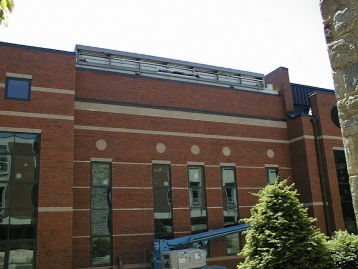 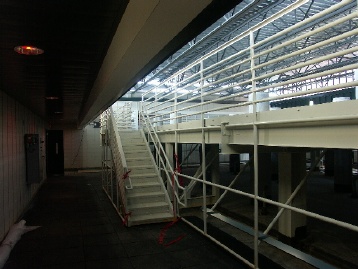 |
|
| The observing deck is vibrationally isolated from the telescope piers and is directly accessed from the adjacent laboratory room which is equipped with 18 computer worktables, one for each telescope station. It is our philosophy that the students should be "out under the stars" doing hands-on operating of the telescopes as much as possible. Since the telescopes and cameras can be operated directly on the deck, students will do both visual observations and digital imaging while outside. However, since both the telescopes and cameras can be operated remotely as well, the students will be able to operate them from the laboratory room when the outside temperatures are too harsh for direct work at the telescope. This also increases the number of usable clear nights in the winter months. Of course we have not yet solved the problem of actually controlling the weather, so on cloudy night the studentsl carry out a variety of indoor exercises that will include the analysis of the images and data that they and their fellow students have already obtained. | |
The Instrumentation |
|
| Shown below is a Meade 10" GoTo telescope and the attached SBIG STV ccd camera that will be used in the new facility. This is one of three of these systems that were used in our astronomy labs by rolling them outside on their carts during the time that our new building was under construction. They are equipped with a flip mirror system to allow either imaging or visual observations. With the addition of a Star Spectroscope grating they are also used for spectroscopy of bright stars. We have found both the telescope and the camera to be extremely user friendly with shallow learning curves. That makes them ideal in the tour, camp and workshop environments as well. The telescope actually finally chose for use in the GoTo Lab is the Celestron C11, shown at the bottom, below. | |
 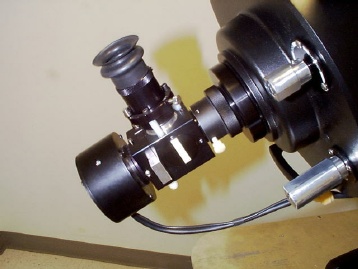 |
|
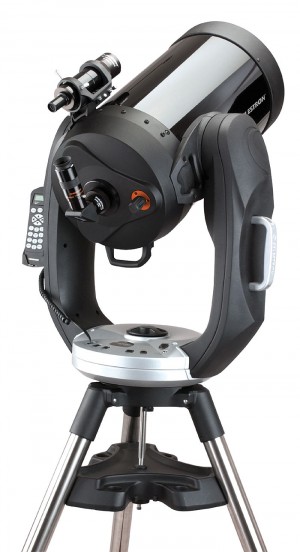 Celestron C11
Celestron C11
The Celestron C11 was found to have superior pointing capabilities and reliability, and was thus chosen as the instrument for our lab. Ours are mounted on permanent piers under the roll-off roof, not on the tripod as shown in this picture from the Celestron web site.
The telescopes are controllable from inside the adjacent lab room, vie PCs. They can be pointed and digitial images acquired in the comfort of that room on cold and/or breezy nights, or operated from the telescope on nice evenings.